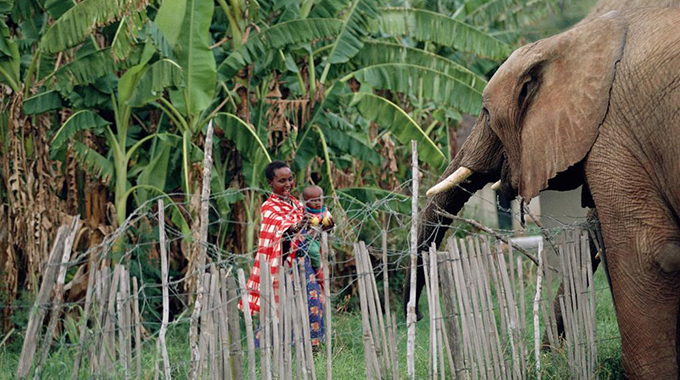Leonard Ncube, [email protected]
COMMUNITIES living near game parks have called for the restoration of the security fence separating wildlife areas from human settlements as a permanent solution to the rampant human-wildlife conflict.
Cases of human-wildlife conflict continue to escalate in communities adjacent to game parks where villagers have lost livestock, crops and some either being killed or injured.
Government is already working towards introducing a Human-Wildlife Conflict Fund and has come up with a nationwide programme of engagement with key stakeholders in affected areas under the Ministry of Environment, Climate and Wildlife.
Last week Environment Minister Nqobizitha Mangaliso Ndlovu visited Hwange District where he met traditional leaders and communities after similar exercises in Tsholotsho and Bulilima districts.
During deliberations, there was a consensus on the need to erect a security fence along highways separating game parks from communities.
In recent years, the fence was vandalised by people who reportedly stole its components for use at their homesteads and fields while some made wire snares to trap animals.
Feeling the heat from the loss of property, lives and livestock, villagers in Bulilima, Hwange and Tsholotsho want the fence restored to keep away wildlife. This comes as wild species, especially elephants, lions, hyenas, jackals and wild dogs among others stray into communities where they terrorise villagers resulting in conflict and illegal hunting. The absence of a fence also puts motorists and travellers at risk of accidents with both domestic and wild animals while villagers also freely drive their cattle into protected areas for grazing.
In some area departments such as the Forestry Commission and Veterinary Services as a response to vandalism, while some sections were opened after the introduction of the Community Areas Management Programme for Indigenous Resources (Campfire) to allow wild animals to certain communities that had been given hunting quotas outside the game parks.
Villagers want the Government to activate some laws that criminalise vandalism of infrastructure, especially the security fence.
“We in Mangondoma area are close to the forest area and the fence was vandalised so we now have a free walk of animals into the community because there is no restriction or boundary between the community and animals,” said one of the villagers during the meeting. “We wish animals could be driven back to the park and kept there in a fence permanently.”

Another participant said the fence was there before being vandalised by people for wire snares and fencing homesteads.
Chief Dingane-Nelukoba of Mabale in whose area the meeting was held said because of lack of fencing, lions were now hunting in people’s livestock pens.
“They kill cattle in the presence of herd boys in the bush. It’s not that people drive cattle into the park but they come to villages and into grazing areas. We don’t know what to do. We don’t want people to end up taking the law into their own hands,” he said.
“The truth is that after seeing that the fence was being vandalised, the Forestry Commission removed it together with poles but it is us, villagers that started vandalising and using it to make wire snares to trap animals,” said Chief Dingane-Nelukoba.
He commended the Government for engaging the community and urged his subjects to abide by the country’s laws and commended partner organisations such as the International Fund for Animal Welfare (Ifaw) for empowering communities with Boma’s pens.
Ifaw is building Boma pens for villagers as a wildlife conflict mitigating measure as they protect domestic animals from being attacked by wild animals.
The Bomas are part of Ifaw’s “room-to-roam initiative” being implemented to secure landscapes and maintain connectivity for elephants and other wildlife in Kaza.
Minister Ndlovu said Matabeleland North, particularly Hwange has the fastest growing elephant population because of anti-poaching and sustainable conservation strategies in Hwange National Park, gazetted forestlands and other private conservancies.
With the region facing serious El Nino-induced drought, wildlife migration into communities is set to increase, especially with overpopulation in Hwange National Park where there are over 65 000 elephants, according to an aerial elephant survey conducted by the Kavango Zambezi Transfrontier Conservation Area (Kaza-Tfca) last year.
The overpopulation of elephants in the biggest game park, which is home to more than 100 mammal and 400 bird species, has been blamed for human-wildlife conflict, migration of animals and death of some wildlife as the jumbos are known for destroying habitat and water sources.
“What I am picking here is that people are saying the game park should be fenced and communities want the fence restored. It is important that we come up with a local solution to these problems,” said the minister.
“I found similar concerns in Bulilima and Tsholotsho. In Bulilima they said there used to be an electric fence and today people are complaining that animals stray into communities and attack livestock because the fence was vandalised. Today you are admitting that ‘it is us’ that vandalised the fence.
Natural resources officer for Hwange RDC Mr Nxolelani Ncube said areas around Mabale, Chikandakubi, Chidobe and others along the highway were hotspots.
